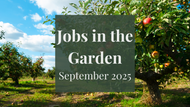Jobs in the Garden: September 2024
4th Sep 2024
Essential Gardening Jobs for September: Preparing Your Garden for Autumn
As summer begins to wane and the first hints of autumn appear, September is a pivotal month in the garden. The days are still warm, but the nights are getting cooler, signalling the start of a new season. It’s a time of transition, where you can enjoy the last of the summer blooms while preparing your garden for the months ahead. Here’s a guide to the essential gardening tasks for September, helping you keep your garden looking its best and ready for autumn.
1. Harvest Late Summer Vegetables and Fruits
September is the time to reap the rewards of your summer labour. Many vegetables, such as tomatoes, courgettes, and beans, will be reaching their peak, so be sure to harvest them regularly to encourage more growth. If you’ve grown fruits like apples, pears, or plums, now is the time to start picking them as well. Check your produce daily, as the cooler nights can cause ripening to speed up.
2. Plant Autumn and Winter Vegetables
As you clear out summer crops, consider planting vegetables that thrive in cooler weather. Spinach, kale, chard, and winter lettuces are all excellent choices for autumn and winter harvesting. You can also plant garlic and onions towards the end of the month, allowing them to establish before the cold weather sets in. These crops will give you fresh produce throughout the colder months, extending your growing season.
3. Tidy Up Flower Beds and Borders
September is the perfect time to tidy up your flower beds and borders. Deadhead any remaining summer flowers to keep them blooming a little longer, and remove any plants that have finished for the season. This is also an excellent time to divide and replant perennials, ensuring they have enough space to grow and flourish next year. Cutting back faded perennials can help keep your garden looking neat, and the trimmed foliage can be added to your compost heap.
4. Plant Spring-Flowering Bulbs
To ensure a vibrant display of flowers in the spring, September is the ideal month to plant bulbs. Daffodils, crocuses, tulips, and hyacinths can all be planted now. Choose a sunny spot with well-drained soil, and plant the bulbs at a depth of about three times their height. By planning ahead and planting in September, you’ll be rewarded with a stunning spring display when the warmer weather returns.
5. Prune Shrubs and Hedges
As growth slows down, September is a good time to give your shrubs and hedges a final prune. Trimming them back will help maintain their shape and prevent them from becoming overgrown. Be mindful not to cut too late in the month, as this can encourage new growth that may be damaged by early frosts. Focus on removing dead or diseased wood and thinning out overcrowded areas to improve air circulation.
6. Lawn Care
After a summer of heavy use, your lawn may be in need of some attention. Early September is an excellent time to scarify (remove thatch and moss), aerate, and apply an autumn fertiliser to strengthen the grass before winter. If you have any bare patches, reseed them now so they have time to establish before the colder weather arrives. Regular mowing will also help keep the lawn tidy, but you should gradually raise the mower blades to prepare the grass for winter.
7. Collect and Compost Fallen Leaves
As the leaves start to fall, make sure to collect them regularly to prevent them from smothering your lawn or flower beds. Fallen leaves are a valuable resource for your garden, so consider starting a leaf mould pile or adding them to your compost heap. Leaf mould is an excellent soil conditioner, breaking down over time to create a rich, dark humus that will benefit your garden in the years to come.
8. Prepare for Frost
While frosts may still be a few weeks away, it’s wise to start thinking about protecting tender plants. Bring any delicate potted plants indoors or move them to a sheltered spot. For plants that need to stay outside, such as young trees or shrubs, consider using fleece or cloches to shield them from the cold. Preparing early will help prevent damage when the first frosts arrive unexpectedly.
9. Plant New Trees and Shrubs
September is an excellent time to plant new trees and shrubs. The soil is still warm, which encourages root growth, and the cooler temperatures reduce stress on the plants. Whether you’re adding a new focal point to your garden or establishing a hedge, planting in September gives your trees and shrubs plenty of time to establish before the winter.
10. Plan for Next Year
As you work through your September gardening tasks, take some time to reflect on the successes and challenges of the past season. Consider what worked well and what you might do differently next year. Make notes on where you’d like to plant bulbs, which vegetables you’d like to try, and any new plants you’re eager to add. Planning ahead will make your garden even more enjoyable and productive in the future.
September is a busy but rewarding month in the garden. By tackling these essential tasks, you’ll not only keep your garden looking beautiful but also set the stage for a successful autumn and winter. Whether you’re harvesting the last of your summer crops, planting for the future, or simply tidying up, the work you put in now will pay off in the months to come. Happy gardening!






